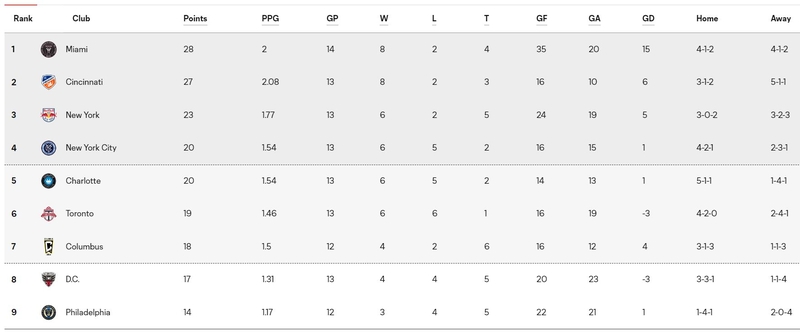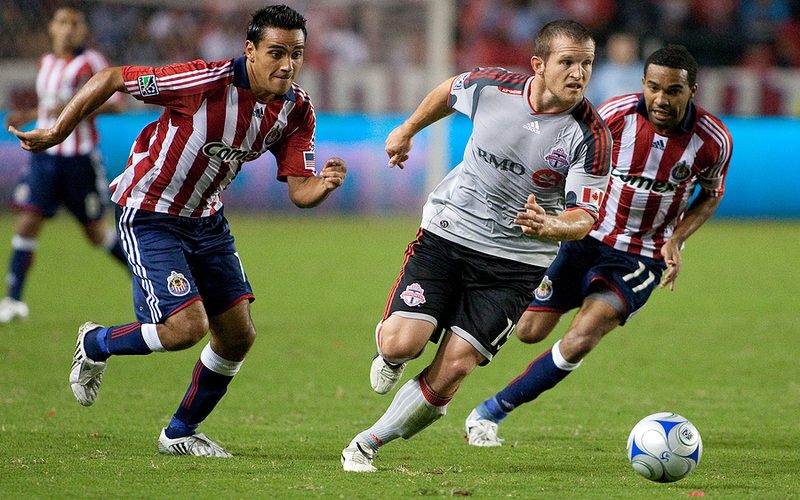The Major League Soccer (MLS) points system determines the standings and playoff seeding for teams in the league.
Unlike other American sports leagues that use winning percentage to rank teams, MLS uses a points-based system which is similar to most other soccer leagues around the world.
Here is a detailed explanation of how MLS points work.
The Basics – Points for Wins, Draws, and Losses
MLS teams are awarded points based on the result of each regular season match they play:
- 3 Points for a Win – If a team wins a match, they receive 3 points in the standings. This applies whether the match ends in regulation, extra time, or a shootout. Although, typically, shootouts are reserved for knock out competitions.
- 1 Point for a Draw – If a match ends in a tie after regulation or extra time, each team receives 1 point. In knockout competitions a winner is needed, so draws will not be possible in this case.
- 0 Points for a Loss – Teams receive 0 points in the standings for a lost match, regardless if it ends in regulation or extra time.
Teams are ranked in the standings based on total points earned. The team with the most points tops the table.
Tiebreakers
If two or more teams are tied on total points, tiebreaking procedures are used to determine positioning in the standings.
MLS tiebreakers operate on the following hierarchy:
- Most Total Wins – The team with more total wins takes the higher spot.
- Goal Differential – Goal differential (goals scored minus goals conceded) is used to break the tie. The team with the higher differential gets the higher position.
- Goals For – If teams are still tied, total goals scored is used as the next tiebreaker. More goals scored takes precedence.
- Fewest Disciplinary Points – Teams accumulate disciplinary points for yellow and red cards. The team with the fewest disciplinary points prevails at this stage.
- Road Goals Differential – Differential of road goals scored/allowed is utilized next. Higher differential wins the tiebreaker.
- Road Goals For – Total road goals scored serves as the next tiebreaker if still necessary.
- Home Goals Differential – Differential of home goals scored/allowed breaks any remaining tie.
- Home Goals For – Total goals scored on home soil.
- Coin Toss – If all previous tiebreakers fail to separate teams, a simple coin toss decides.
These tiebreaking steps ensure the standings can separate teams based on sporting merit when total points are equal, although it is extremely rare that it comes down to any of the tiebreaks below goal differential.
Points Per Game
In addition to total points earned, MLS also calculates points per game (PPG) for each team. This metric tracks the average points a team obtains per match played. Points per game comes into play when:
- Teams have played an unequal number of matches. Looking at PPG normalizes comparisons.
- The regular season ends, but not all teams have played the full 34 games due to postponements. PPG determines playoff seeding.
For example, after 20 matches Team A has 38 points (1.9 PPG) while Team B has 36 points (1.8 PPG) from only 20 games played. Despite having fewer total points, Team A ranks higher by points per game (1.9 vs 1.8).
Points per game gives a snapshot of which teams are most consistently earning results on average all season. It becomes very important if teams end up playing an unbalanced schedule.
Using Points to Make the Playoffs

The ultimate goal of racking up regular season points is to make the MLS Cup playoffs.
Here is how points lead to the postseason:
- The top 7 teams from both the Eastern and Western Conferences automatically qualify for the playoffs, with 8th and 9th placed teams playing a wild card round to claim the 8th playoff place.
- Total points determine playoff seeding within each conference. The top seed gets home field advantage.
- In addition, the top seeded team in each conference will face the lowest seeded playoff qualifying team in the first round, meaning those lower ranking teams must work harder to progress through the post season.
- Playoff seeding continues to determine who gets the home advantage all the way to the MLS Cup.
So regular season points form the foundation for eventually competing for the iconic MLS Cup trophy, with those who have performed best in the regular season gaining a well earned advantage in the playoffs.
Supporters’ Shield Winner
While the MLS Cup Playoffs decide the league champion, MLS also awards the Supporters’ Shield trophy to the team that tops the overall regular season table with the most points accumulated across both conferences.
This award goes to the team that demonstrates excellence through consistent point production over the long 34 match regular season. Teams aim to both make a deep playoff run for MLS Cup glory and secure the Supporters’ Shield for regular season domination.
LAFC demonstrated this achievement by winning both trophies in 2022.
The Supporters Shield ensures that any team who enjoys a successful regular season is rewarded, even if they don’t make it to the MLS Cup final.
Points Impact MLS History and Culture
Since MLS utilizes a unique points system compared to other prominent domestic sports leagues, it shapes certain dynamics and incentives within the competition:
- Coaches and players emphasize getting results each match to continually stockpile points. Early points provide a buffer later on.
- Teams are less likely to “tank” or strategically lose down the stretch if they have slim playoff hopes since every point matters.
- Supporters’ Shield contenders push till the end to claim the coveted regular season title.
- Rivalries brew between tightly-packed teams aiming to move up just one spot in competitive conference races.
- MLS table positions and permutations get analyzed to an intricate level based on points probabilities.
So a premium on points influences culture and behavior across the league. Fans track the race to the playoffs and Shield trophy with attention to each passing point.
Historical Context Shows Evolution of MLS Points System

When Major League Soccer first launched in 1996, the league utilized a simpler points structure similar to other American sports leagues – 2 points for a win, 1 point for a draw. This format persisted through the 1998 season until MLS shifted to the now familiar 3 points for a win and 1 point for a draw system.
This brought MLS in line with prominent soccer leagues across Europe and South America, easing potential transitions for imported players already accustomed to the format. It also helped the young league mirror global counterparts it aspired to compete with down the road by utilizing a universal soccer table system.
Compared to American sports leagues relying solely on winning percentage like the NBA, NFL and MLB, MLS uniquely developed under a global points format more reflective of greater soccer traditions worldwide. Over two decades later, that 3-1-0 points structure drives competitive incentives and determines success for the burgeoning North American circuit.
Points Structure and Global Comparisons
Supporters can also gain perspective by measuring MLS club success against teams in prominent overseas leagues, and this is partially because MLS uses the same points system.
Contrasting differences in wages, transfer budgets, competition formats and playing styles do exist between North American and European circuits. Realistically assessing where leading MLS sides would fare if inserted into top English, German or Mexican leagues for a full campaign becomes an interesting hypothetical. The harsh truth is most MLS teams likely would struggle at the bottom of EPL or Bundesliga tables, or battle relegation given considerable gaps in squad talent and depth compared to overseas giants like Manchester City or Bayern Munich.
However, MLS has made strides in recent CONCACAF Champions League tournaments, proving capable of competing with and defeating Mexican powers in meaningful knockout ties. As the quality gap closes gradually and MLS continues investing in talent, its 3-1-0 points system tying directly to the global game provides a foundation for growth.

